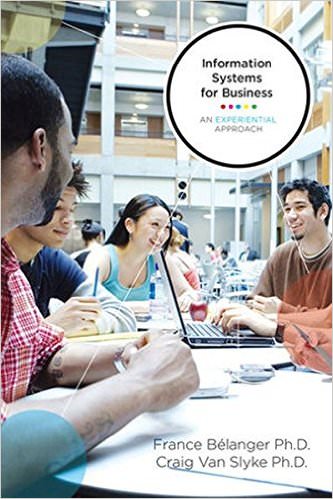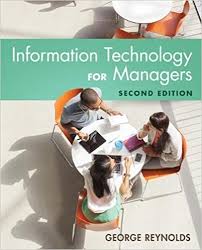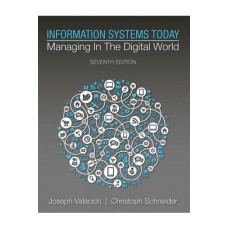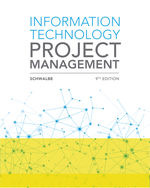Description
Test Bank For Information Systems For Business An Experiential Approach 1st Edition By Craig Van
Chapter 1: The Value of Information
Test Bank
Multiple Choice
1. Data can best be described as:
a. raw symbols (unconnected facts) (ref 1-5)
b. information
c. wisdom
d. knowledge
e. software
2. Data that has been processed into something useful is:
a. raw data
b. information (ref 1-5)
c. knowledge
d. wisdom
e. hardware
3. What is the difference between data and information?
a. Data is raw and is converted to information once it has been processed. (ref 1-5)
b. Information is knowledge, data is not.
c. Data is stored, information is not.
d. Data must be numbers, information must be text.
e. They are the same thing.
4. Knowledge can best be described as:
a. data
b. a person, place or thing
c. information that is applied to some decision or action (ref 1-5)
d. the description of information
e. stored data
5. Wisdom involves:
a. age and life experience
b. formal education
c. using consultants
d. reviewing data
e. using knowledge for the greater good (ref 1-5)
6. When considering data, information, knowledge and wisdom as a hierarchy, which of these is deeper and more uniquely human?
a. Data
b. Information
c. Knowledge
d. Wisdom (ref 1-5)
e. None of the above
7. The hardware, software and media used to store, organize, retrieve and communicate information is known as __________.
a. information technology (ref 1-6, glossary)
b. information systems
c. usefulness
d. connectedness
e. data
8. What is information technology?
a. The hardware used in an organization
b. An information system
c. The hardware, software and media used to store, organize, retrieve and communicate information (ref 1-6)
d. Applying technology to organizations
e. Applying technology to systems
9. What is the hardware, software and media used to store, organize, retrieve and communicate information called?
a. Information technology (ref 1-6)
b. Information systems
c. Hardware
d. Software
e. Usefulness
10. Information systems enable users to ____________.
a. research alternative solutions
b. identify business strategic solutions
c. connect and process data to help with management decision making (ref 1-6)
d. store data
e. share information rapidly
11. Two important concepts that are framed by understanding the DIK hierarchy are:
a. connectedness and usefulness (ref 1-6)
b. time and location
c. news and opinion
d. relevance and timeliness
e. intelligence and data
12. ____________ combinesbits of data giving the data some context and meaning.
a. Identifying subsystems
b. Labeling relationships
c. Developing scenarios
d. Connecting data elements (ref 1-6)
e. Correcting errors
13. To be useful, information is ______ and ________ ,which leads to knowledge.
a. understood, explained
b. interpreted, applied (ref 1-6)
c. complete, evaluated
d. reviewed, approved
e. identified, dissected
14. The ability to efficiently and effectively determine what information is needed, then access, evaluate, use, and manage that information in an ethical manner is__________.
a. information literacy (ref 1-7)
b. information technology
c. information systems
d. connectedness and usefulness
e. information knowledge
15. What are the three main purposes that all business use information for?
a. Reading, writing, and arithmetic
b. Data, storage, and hardware
c. Software, communications, and process support
d. Decision-making, software, and hardware
e. Communications, process support, and decision-making (ref 1-10)
16. A set of coordinated activities that lead to a specific goal or outcome is known as:
a. rules
b. business process (ref 1-10)
c. strategic goals
d. management directives
e. vision
17. Decision making involves choosing alternatives. Making this choice requires ____________.
a. researching every available source
b. reviewing unsolicited information
c. information about the alternatives (ref 1-12)
d. full knowledge of all available options
e. input from management
18. Individuals in information systems careers ______________.
a. create, and develop websites
b. design, build, support or manage information systems (ref 1-14)
c. define organization vision
d. purchase hardware
e. maintain databases
19. People in __________________ careers use systems to retrieve, report on and analyze information contained in systems.
a. information systems
b. information research
c. insurance adjusters
d. information analysis (ref 1-14)
e. accounting and finance
20. Which part of an “information system” is the most critical?
a. The system
b. The information (ref page 1)
c. The data
d. The knowledge
e. The technology
21. What is believed to be the most critical skill for the future?
a. Wise decision making
b. Information management
c. Knowledge management
d. Information discovery
e. Information literacy (ref page 5)
22. _________ is a process by which information is exchanged between individuals through a common system of symbols, signs, or behavior.
a. Knowledge sharing
b. Text messaging
c. Communication (ref page 6)
d. Language
e. Information Literacy
23. Which of the following is information that is applied to some decision or action?
a. Data
b. Wisdom
c. Knowledge (ref 1-5)
d. Decision making
e. Information literacy
24. Which of the following refers to using knowledge for the greater good?
a. Data processing
b. Ethics
c. Information literacy
d. Decision making
e. Wisdom(ref 1-5)
25. ______________ enable users to connect and process data to help with management decision making.
a. Decision making tools
b. Information technologies
c. Information systems (ref 1-6)
d. Knowledge management systems
e. Expert systems
Reflection Questions
1. Plan a productive day without using any information technology. What are the biggest challenges that you will face? (ref 1-4)
Answers will vary
2. If you were looking to buy a home, how would you begin to do research about purchasing a home? (ref 1-9)
Answers will vary





Be the first to review “Test Bank For Information Systems For Business An Experiential Approach 1st Edition By Craig Van”